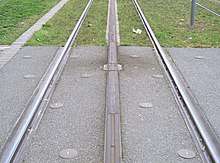Tram
A tram (in North America streetcar or trolley) is a rail vehicle that runs on tramway tracks along public urban streets; some include segments of segregated right-of-way.[1][2] The lines or networks operated by tramcars are called tramways. Historically the term electric street railways was also used in the United States. In the United States, the term tram has sometimes been used for rubber-tired trackless trains, which are unrelated to other kinds of trams.
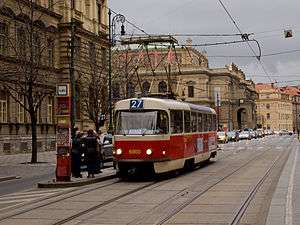
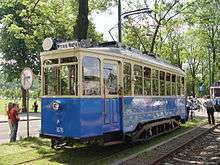
Tram vehicles are usually lighter and shorter than main line and rapid transit trains. Today, most trams use electrical power, usually fed by a pantograph sliding on an overhead line; older systems may use a trolley pole or a bow collector. In some cases, a contact shoe on a third rail is used. If necessary, they may have dual power systems—electricity in city streets and diesel in more rural environments. Occasionally, trams also carry freight.
Trams are now commonly included in the wider term "light rail",[3] which also includes grade-separated systems. Some trams, known as tram-trains, may have segments that run on mainline railway tracks, similar to interurban systems. The differences between these modes of rail transport are often indistinct and a given system may combine multiple features.
One of the advantages over earlier forms of transit was the low rolling resistance of metal wheels on steel rails, allowing the trams to haul a greater load for a given effort. Problems included the high total cost of ownership of horses. Electric trams largely replaced animal power in the late 19th and early 20th centuries. Improvements in other vehicles such as buses led to decline of trams in the mid 20th century. However, trams have seen resurgence in recent years.
Etymology and terminology
The English terms tram and tramway are derived from the Scots word tram,[4] referring respectively to a type of truck (goods wagon or freight railroad car) used in coal mines and the tracks on which they ran. The word tram probably derived from Middle Flemish trame ("beam, handle of a barrow, bar, rung"). The identical word la trame with the meaning "crossbeam" is also used in the French language. Etymologists believe that the word tram refers to the wooden beams the railway tracks were initially made of before the railroad pioneers switched to the much more wear-resistant tracks made of iron and, later, steel.[5] The word Tram-car is attested from 1873.[6]

Although the terms tram and tramway have been adopted by many languages, they are not used universally in English; North Americans prefer streetcar, trolley, or trolleycar. The term streetcar is first recorded in 1840, and originally referred to horsecars. When electrification came, Americans began to speak of trolleycars or later, trolleys. A widely held belief holds the word to derive from the troller (said to derive from the words traveler and roller), a four-wheeled device that was dragged along dual overhead wires by a cable that connected the troller to the top of the car and collected electrical power from the overhead wires;[7] this portmanteau derivation is, however, most likely folk etymology. "Trolley" and variants refer to the verb troll, meaning "roll" and probably derived from Old French,[8] and cognate uses of the word were well established for handcarts and horse drayage, as well as for nautical uses.[9]
The alternative North American term 'trolley' may strictly speaking be considered incorrect, as the term can also be applied to cable cars, or conduit cars that instead draw power from an underground supply. Conventional diesel tourist buses decorated to look like streetcars are sometimes called trolleys in the US (tourist trolley). Furthering confusion, the term tram has instead been applied to open-sided, low-speed segmented vehicles on rubber tires generally used to ferry tourists short distances, for example on the Universal Studios backlot tour and, in many countries, as tourist transport to major destinations. The term may also apply to an aerial ropeway, e.g. the Roosevelt Island Tramway.
Although the use of the term trolley for tram was not adopted in Europe, the term was later associated with the trolleybus, a rubber-tyred vehicle running on hard pavement, which draws its power from pairs of overhead wires. These electric buses, which use twin trolley poles, are also called trackless trolleys (particularly in the northeastern US), or sometimes simply trolleys (in the UK, as well as the Pacific Northwest, including Seattle, and Vancouver).
The New South Wales government in Australia has decided to use the term "light rail" for their trams.
History
The history of trams, streetcars or trolley systems, began in the early nineteenth century. It can be divided up into several discrete periods defined by the principal means of motive power used.
Horse-drawn
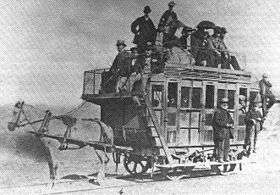
The world's first passenger train or tram was the Swansea and Mumbles Railway, in Wales, UK. The Mumbles Railway Act was passed by the British Parliament in 1804, and horse-drawn service started in 1807.[10] The service closed in 1827, but was restarted in 1860, again using horses.[11] It was worked by steam from 1877, and then, from 1929, by very large (106-seater) electric tramcars, until closure in 1961. The Swansea and Mumbles Railway was something of a one-off however, and no street tramway would appear in Britain until 1860 when one was built in Birkenhead by the American George Francis Train.[12]
Street railways developed in America before Europe, largely due to the poor paving of the streets in American cities which made them unsuitable for horsebuses, which were then common on the well-paved streets of European cities. Running the horsecars on rails allowed for a much smoother ride. There are records of a street railway running in Baltimore as early as 1828, however the first authenticated streetcar in America, was the New York and Harlem Railroad developed by the Irish coach builder John Stephenson, in New York City which began service in the year 1832.[13][14] The New York and Harlem Railroad's Fourth Avenue Line ran along the Bowery and Fourth Avenue in New York City. It was followed in 1835 by the New Orleans and Carrollton Railroad in New Orleans, Louisiana,[15] which still operates as the St. Charles Streetcar Line. Other American cities did not follow until the 1850s, after which the "animal railway" became an increasingly common feature in the larger towns.[15]
The first permanent tram line in continental Europe was opened in Paris in 1855 by Alphonse Loubat who had previously worked on American streetcar lines.[16] The tram was developed in numerous cities of Europe (some of the most extensive systems were found in Berlin, Budapest, Birmingham, Leningrad, Lisbon, London, Manchester, Paris).
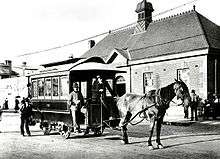
The first tram in South America opened in 1858 in Santiago, Chile. The first trams in Australia opened in 1860 in Sydney. Africa's first tram service started in Alexandria on 8 January 1863. The first trams in Asia opened in 1869 in Batavia (now Jakarta), Netherlands East Indies (now Indonesia).
Problems with horsecars included the fact that any given animal could only work so many hours on a given day, had to be housed, groomed, fed and cared for day in and day out, and produced prodigious amounts of manure, which the streetcar company was charged with storing and then disposing of. Since a typical horse pulled a streetcar for about a dozen miles a day and worked for four or five hours, many systems needed ten or more horses in stable for each horsecar.
Horsecars were largely replaced by electric-powered trams following the improvement of an overhead trolley system on trams for collecting electricity from overhead wires by Frank J. Sprague. His spring-loaded trolley pole used a wheel to travel along the wire. In late 1887 and early 1888, using his trolley system, Sprague installed the first successful large electric street railway system in Richmond, Virginia. Within a year, the economy of electric power had replaced more costly horsecars in many cities. By 1889, 110 electric railways incorporating Sprague's equipment had been begun or planned on several continents.[17]
Horses continued to be used for light shunting well into the 20th century, and many large metropolitan lines lasted into the early 20th century. New York City had a regular horsecar service on the Bleecker Street Line until its closure in 1917.[18] Pittsburgh, Pennsylvania, had its Sarah Street line drawn by horses until 1923. The last regular mule-drawn cars in the US ran in Sulphur Rock, Arkansas, until 1926 and were commemorated by a U.S. postage stamp issued in 1983.[19] The last mule tram service in Mexico City ended in 1932, and a mule tram in Celaya, Mexico, survived until 1954.[20] The last horse-drawn tram to be withdrawn from public service in the UK took passengers from Fintona railway station to Fintona Junction one mile away on the main Omagh to Enniskillen railway in Northern Ireland. The tram made its last journey on 30 September 1957 when the Omagh to Enniskillen line closed. The "van" now lies at the Ulster Transport Museum.
Horse-drawn trams still operate on the 1876-built Douglas Bay Horse Tramway in the Isle of Man, and at the 1894-built horse tram at Victor Harbor in South Australia. New horse-drawn systems have been established at the Hokkaidō Museum in Japan and also in Disneyland. A horse tram route in Polish gmina Mrozy, first built in 1902, was reopened in 2012.
Steam
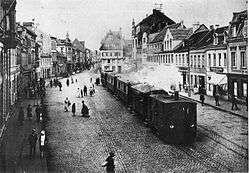
The first mechanical trams were powered by steam. Generally, there were two types of steam tram. The first and most common had a small steam locomotive (called a tram engine in the UK) at the head of a line of one or more carriages, similar to a small train. Systems with such steam trams included Christchurch, New Zealand; Sydney, Australia; other city systems in New South Wales; Munich, Germany (from August 1883 on),[21] British India (Pakistan) (from 1885) and the Dublin & Blessington Steam Tramway (from 1888) in Ireland. Steam tramways also were used on the suburban tramway lines around Milan and Padua; the last Gamba de Legn ("Peg-Leg") tramway ran on the Milan-Magenta-Castano Primo route in late 1957.[22]
The other style of steam tram had the steam engine in the body of the tram, referred to as a tram engine (UK) or steam dummy (US). The most notable system to adopt such trams was in Paris. French-designed steam trams also operated in Rockhampton, in the Australian state of Queensland between 1909 and 1939. Stockholm, Sweden, had a steam tram line at the island of Södermalm between 1887 and 1901.
Tram engines usually had modifications to make them suitable for street running in residential areas. The wheels, and other moving parts of the machinery, were usually enclosed for safety reasons and to make the engines quieter. Measures were often taken to prevent the engines from emitting visible smoke or steam. Usually the engines used coke rather than coal as fuel to avoid emitting smoke; condensers or superheating were used to avoid emitting visible steam. A major drawback of this style of tram was the limited space for the engine, so that these trams were usually underpowered. Steam tram engines faded out around the 1890s to 1900s, being replaced by electric trams.
Cable-hauled
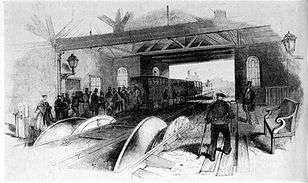
Another motive system for trams was the cable car, which was pulled along a fixed track by a moving steel cable. The power to move the cable was normally provided at a "powerhouse" site a distance away from the actual vehicle. The London and Blackwall Railway, which opened for passengers in east London, England, in 1840 used such a system.[23]
The first practical cable car line was tested in San Francisco, in 1873. Part of its success is attributed to the development of an effective and reliable cable grip mechanism, to grab and release the moving cable without damage. The second city to operate cable trams was Dunedin in New Zealand, from 1881 to 1957.
The most extensive cable system in the US was built in Chicago, having been built in stages between 1859 and 1892. New York City developed multiple cable car lines, that operated from 1883 to 1909.[24] Los Angeles also had several cable car lines, including the Second Street Cable Railroad, which operated from 1885 to 1889, and the Temple Street Cable Railway, which operated from 1886 to 1898.
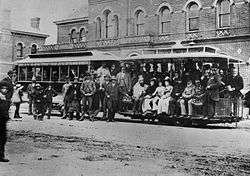
From 1885 to 1940, the city of Melbourne, Victoria, Australia operated one of the largest cable systems in the world, at its peak running 592 trams on 75 kilometres (47 mi) of track. There were also two isolated cable lines in Sydney, New South Wales, Australia; the North Sydney line from 1886 to 1900,[25] and the King Street line from 1892 to 1905.
In Dresden, Germany, in 1901 an elevated suspended cable car following the Eugen Langen one-railed floating tram system started operating. Cable cars operated on Highgate Hill in North London and Kennington to Brixton Hill In South London. They also worked around "Upper Douglas" in the Isle of Man from 1897 to 1929 (cable car 72/73 is the sole survivor of the fleet).
Cable cars suffered from high infrastructure costs, since an expensive system of cables, pulleys, stationary engines and lengthy underground vault structures beneath the rails had to be provided. They also required physical strength and skill to operate, and alert operators to avoid obstructions and other cable cars. The cable had to be disconnected ("dropped") at designated locations to allow the cars to coast by inertia, for example when crossing another cable line. The cable would then have to be "picked up" to resume progress, the whole operation requiring precise timing to avoid damage to the cable and the grip mechanism. Breaks and frays in the cable, which occurred frequently, required the complete cessation of services over a cable route while the cable was repaired. Due to overall wear, the entire length of cable (typically several kilometres) would have to be replaced on a regular schedule. After the development of reliable electrically powered trams, the costly high-maintenance cable car systems were rapidly replaced in most locations.
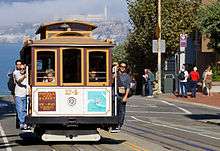
Cable cars remained especially effective in hilly cities, since their nondriven wheels would not lose traction as they climbed or descended a steep hill. The moving cable would physically pull the car up the hill at a steady pace, unlike a low-powered steam or horse-drawn car. Cable cars do have wheel brakes and track brakes, but the cable also helps restrain the car to going downhill at a constant speed. Performance in steep terrain partially explains the survival of cable cars in San Francisco.
The San Francisco cable cars, though significantly reduced in number, continue to perform a regular transportation function, in addition to being a well-known tourist attraction. A single cable line also survives in Wellington, New Zealand (rebuilt in 1979 as a funicular but still called the "Wellington Cable Car"). Another system, actually two separate cable lines with a shared power station in the middle, operates from the Welsh town of Llandudno up to the top of the Great Orme hill in North Wales, UK.
Gas
In the late 19th and early 20th centuries a number of systems in various parts of the world employed trams powered by gas, naphtha gas or coal gas in particular. Gas trams are known to have operated between Alphington and Clifton Hill in the northern suburbs of Melbourne, Australia (1886–1888); in Berlin and Dresden, Germany; in Estonia (1921–1951); between Jelenia Góra, Cieplice, and Sobieszów in Poland (from 1897); and in the UK at Lytham St Annes, Neath (1896–1920), and Trafford Park, Manchester (1897–1908).
On 29 December 1886 the Melbourne newspaper The Argus reprinted a report from the San Francisco Bulletin that Mr Noble had demonstrated a new 'motor car' for tramways 'with success'. The tramcar 'exactly similar in size, shape, and capacity to a cable grip car' had the 'motive power' of gas 'with which the reservoir is to be charged once a day at power stations by means of a rubber hose'. The car also carried an electricity generator for 'lighting up the tram and also for driving the engine on steep grades and effecting a start'.[26]
Comparatively little has been published about gas trams. However, research on the subject was carried out for an article in the October 2011 edition of "The Times", the historical journal of the Australian Association of Timetable Collectors, now the Australian Timetable Association.[27][28][29][30]
A tram system powered by compressed natural gas was due to open in Malaysia in 2012,[31] but the news about the project appears to have dried up.
Electric
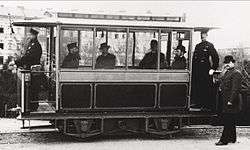
The world's first electric tram line operated in Sestroretsk near Saint Petersburg, Russia, invented and tested by Fyodor Pirotsky in 1875.[32][33] Later, using a similar technology, Pirotsky put into service the first public electric tramway in St. Petersburg, which operated only during September 1880.[34] The second demonstrative tramway was presented by Siemens & Halske at the 1879 Berlin Industrial Exposition. The first public electric tramway used for permanent service was the Gross-Lichterfelde tramway in Lichterfelde near Berlin in Germany, which opened in 1881. It was built by Werner von Siemens who contacted Pirotsky. This was world's first commercially successful electric tram. It initially drew current from the rails, with overhead wire being installed in 1883.[35]
In Britain, Volk's Electric Railway was opened in 1883 in Brighton). This two kilometer line along the seafront, re-gauged to 2 ft 9 in (838 mm) in 1884, remains in service to this day and is the oldest operating electric tramway in the world. Also in 1883, Mödling and Hinterbrühl Tram was opened near Vienna in Austria. It was the first tram in the world in regular service that was run with electricity served by an overhead line with pantograph current collectors. The Blackpool Tramway was opened in Blackpool, UK on 29 September 1885 using conduit collection along Blackpool Promenade. This system is still in operation in a modernised form.[36]
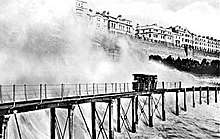
Earliest tram system in Canada was by John Joseph Wright, brother of the famous mining entrepreneur Whitaker Wright, in Toronto in 1883, introducing electric trams in 1892. In the US, multiple functioning experimental electric trams were exhibited at the 1884 World Cotton Centennial World's Fair in New Orleans, Louisiana, but they were not deemed good enough to replace the Lamm fireless engines then propelling the St. Charles Avenue Streetcar in that city. The first commercial installation of an electric streetcar in the United States was built in 1884 in Cleveland, Ohio and operated for a period of one year by the East Cleveland Street Railway Company.[37] Trams were operated in Richmond, Virginia, in 1888, on the Richmond Union Passenger Railway built by Frank J. Sprague. Sprague later developed multiple unit control, first demonstrated in Chicago in 1897, allowing multiple cars to be coupled together and operated by a single motorman. This gave rise to the modern subway train. Following the improvement of an overhead "trolley" system on streetcars for collecting electricity from overhead wires by Sprague, electric tram systems were rapidly adopted across the world.
Earlier electric trains proved difficult or unreliable and experienced limited success until the second half of the 1880s, when new types of current collectors were developed [34]. Siemens' line, for example, provided power through a live rail and a return rail, like a model train, limiting the voltage that could be used, and delivering electric shocks to people and animals crossing the tracks.[38] Siemens later designed his own version of overhead current collection, called the bow collector, and Thorold, Ontario, opened in 1887, and was considered quite successful at the time. While this line proved quite versatile as one of the earliest fully functional electric streetcar installations, it required horse-drawn support while climbing the Niagara Escarpment and for two months of the winter when hydroelectricity was not available. It continued in service in its original form into the 1950s.
Sidney Howe Short designed and produced the first electric motor that operated a streetcar without gears. The motor had its armature direct-connected to the streetcar's axle for the driving force.[39][40][41][42][43] Short pioneered "use of a conduit system of concealed feed" thereby eliminating the necessity of overhead wire and a trolley pole for street cars and railways.[44][39][40] While at the University of Denver he conducted important experiments which established that multiple unit powered cars were a better way to operate trains and trolleys.[39][40]
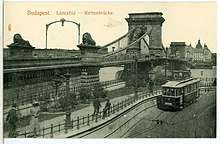
Electric tramways spread to many European cities in the 1890s, such as Prague, Bohemia (then in the Austro-Hungarian Empire), in 1891; Kiev, Ukraine, in 1892 (the first permanent electric tram line in the Russian Empire); Dresden, Germany, Lyon, France, and Milan and Genoa, Italy, in 1893; Rome, Italy, Plauen, Germany, in 1894; Bristol, United Kingdom, Munich, in 1895; Bilbao, Spain, in 1896; Copenhagen, Denmark, and Vienna, Austria, in 1897; Florence and Turin, Italy, in 1898; Helsinki, Finland, and Madrid and Barcelona, Spain, in 1899.[34] Sarajevo built a citywide system of electric trams in 1895.[45] Budapest established its tramway system in 1887, and its ring line has grown to be the busiest tram line in Europe, with a tram running every 60 seconds at rush hour. Bucharest and Belgrade[46] ran a regular service from 1894.[47][48] Ljubljana introduced its tram system in 1901 – it closed in 1958.[49] Oslo had the first tramway in Scandinavia, starting operation on 2 March 1894.[50]
The first electric tramway in Australia was a Sprague system demonstrated at the 1888 Melbourne Centennial Exhibition in Melbourne; afterwards, this was installed as a commercial venture operating between the outer Melbourne suburb of Box Hill and the then tourist-oriented country town Doncaster from 1889 to 1896.[51] As well, electric systems were built in Adelaide, Ballarat, Bendigo, Brisbane, Fremantle, Geelong, Hobart, Kalgoorlie, Launceston, Leonora, Newcastle, Perth, and Sydney.
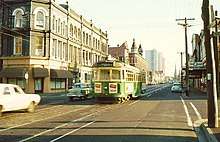
By the 1970s, the only full tramway system remaining in Australia was the Melbourne tram system. However, there were also a few single lines remaining elsewhere: the Glenelg tram line, connecting Adelaide to the beachside suburb of Glenelg, and tourist trams in the Victorian Goldfields cities of Bendigo and Ballarat. In recent years the Melbourne system, generally recognised as the largest urban tram network in the world, has been considerably modernised and expanded.[52] The Adelaide line has also been extended to the Entertainment Centre, and work is progressing on further extensions.[53] Sydney re-introduced trams (or light rail) on 31 August 1997. A completely new system, known as G:link, was introduced on the Gold Coast, Queensland on 20 July 2014. The Newcastle Light Rail opened in February 2019, while the Canberra light rail is scheduled to open in April 2019.[54] This will be the first time that there have been trams in Canberra, even though Walter Burley Griffin's 1914-1920 plans for the capital then in the planning stage did propose a Canberra tram system.[55]
In Japan, the Kyoto Electric railroad was the first tram system, starting operation in 1895.[56] By 1932, the network had grown to 82 railway companies in 65 cities, with a total network length of 1,479 km (919 mi).[57] By the 1960s the tram had generally died out in Japan.[58][59]
Two rare but significant alternatives were conduit current collection, which was widely used in London, Washington, D.C. and New York City, and the surface contact collection method, used in Wolverhampton (the Lorain system), Torquay and Hastings in the UK (the Dolter stud system), and currently in Bordeaux, France (the ground-level power supply system).
The convenience and economy of electricity resulted in its rapid adoption once the technical problems of production and transmission of electricity were solved. Electric trams largely replaced animal power and other forms of motive power including cable and steam, in the late 19th and early 20th centuries.

There is one particular hazard associated with trams powered from a trolley pole off an overhead line. Since the tram relies on contact with the rails for the current return path, a problem arises if the tram is derailed or (more usually) if it halts on a section of track that has been particularly heavily sanded by a previous tram, and the tram loses electrical contact with the rails. In this event, the underframe of the tram, by virtue of a circuit path through ancillary loads (such as interior lighting), is live at the full supply voltage, typically 600 volts DC. In British terminology, such a tram was said to be ‘grounded’—not to be confused with the US English use of the term, which means the exact opposite. Any person stepping off the tram completed the earth return circuit and could receive a nasty electric shock. In such an event, the driver was required to jump off the tram (avoiding simultaneous contact with the tram and the ground) and pull down the trolley pole, before allowing passengers off the tram. Unless derailed, the tram could usually be recovered by running water down the running rails from a point higher than the tram, the water providing a conducting bridge between the tram and the rails.
In the 2000s, two companies introduced catenary-free designs. Alstom's Citadis line uses a third rail, and Bombardier's PRIMOVE LRV is charged by contactless induction plates embedded in the trackway.[60]
Other power sources
In some places, other forms of power were used to power the tram.
Battery
As early as 1834, Thomas Davenport, a Vermont blacksmith, had invented a battery-powered electric motor which he later patented. The following year he used it to operate a small model electric car on a short section of track four feet in diameter.[61][62]
Attempts to use batteries as a source of electricity were made from the 1880s and 1890s, with unsuccessful trials conducted in among other places Bendigo and Adelaide in Australia, and for about 14 years as The Hague accutram of HTM in the Netherlands. The first trams in Bendigo, Australia, in 1892, were battery-powered but within as little as three months they were replaced with horse-drawn trams. In New York City some minor lines also used storage batteries. Then, comparatively recently, during the 1950s, a longer battery-operated tramway line ran from Milan to Bergamo. In China there is a Nanjing battery Tram line and has been running since 2014.[63] More recently in 2019, the West Midlands Metro in Birmingham, England has adopted battery powered trams on sections through the city centre close to Grade I listed Birmingham Town Hall.
Compressed air
Paris and Berne (Switzerland) [64] operated trams that were powered by compressed air using the Mekarski system.
Human power
_Tasmanian_Archives_NS1013-1-1594.jpg)
The Convict Tramway [65] was hauled by human power in the form of convicts from the Port Arthur convict settlement.[66] and was created to replace the hazardous sea voyage from Hobart to Port Arthur, Tasmania.[67][65] Charles O'Hara Booth oversaw the construction of the tramway.[68]
It opened in 1836 and ran for 8 km (5 miles) from Oakwood to Taranna.[69] By most definitions, the tramway was the first passenger-carrying railway/tramway in Australia.[67] An unconfirmed report says that it continued to Eaglehawk Neck and, if this was so, the length of the tramway would have been more than doubled. The tramway carried passengers and freight, and ran on wooden rails. The gauge is unknown. The date of closure is unknown, but it was certainly prior to 1877.[70]
Hydrogen
In March 2015, China South Rail Corporation (CSR) demonstrated the world's first hydrogen fuel cell vehicle tramcar at an assembly facility in Qingdao. The chief engineer of the CSR subsidiary CSR Sifang Co Ltd., Liang Jianying, said that the company is studying how to reduce the running costs of the tram.[71][72]
Hybrid
The Trieste–Opicina tramway in Trieste operates a hybrid funicular tramway system. Conventional electric trams are operated in street running and on reserved track for most of their route. However, on one steep segment of track, they are assisted by cable tractors, which push the trams uphill and act as brakes for the downhill run. For safety, the cable tractors are always deployed on the downhill side of the tram vehicle.
Similar systems were used elsewhere in the past, notably on the Queen Anne Counterbalance in Seattle and the Darling Street wharf line in Sydney.
Liquid fuel
Hastings and some other tramways, for example Stockholms Spårvägar in Sweden and some lines in Karachi, used petrol trams. Galveston Island Trolley in Texas operated diesel trams due to the city's hurricane-prone location, which would result in frequent damage to an electrical supply system.
Although Portland, Victoria promotes its tourist tram[73] as being a cable car it actually operates using a hidden diesel motor. The tram, which runs on a circular route around the town of Portland, uses dummies and salons formerly used on the extensive Melbourne cable tramway system and now beautifully restored.
Modern development
In the mid-20th century many tram systems were disbanded, replaced by buses, automobiles or rapid transit. The General Motors streetcar conspiracy was a case study of the decline of trams in the United States. In the 21st century, trams have been re-introduced in cities where they had been closed down for decades (such as Tramlink in London), or kept in heritage use (such as Spårväg City in Stockholm). Vehicle fabricates from the 1990s and onwards (such as the Bombardier Flexity series and Alstom Citadis) are usually low-floor trams with features such as articulation and regenerative braking.
Design
Trams have been used for two main purposes: for carrying passengers and for carrying cargo. There are several types of passenger tram:
- Articulated
- Double-Decker
- Drop-centre (or drop-center)
- Low-floor
- Single Ended
- Double Ended
- Rubber-tired
- Tram-train
Operation
.JPG_-_panoramio.jpg)
There are two main types of tramways, the classic tramway built in the early 20th century with the tram system operating in mixed traffic, and the later type which is most often associated with the tram system having its own right of way. Tram systems that have their own right of way are often called light rail but this does not always hold true. Though these two systems differ in their operation, their equipment is much the same.
Controls
Trams were traditionally operated with separate levers for applying power and brakes. More modern vehicles use a locomotive-style controller which incorporate a dead man's switch. The success of the PCC streetcar had also seen trams use automobile-style foot controls allowing hands-free operation, particularly when the driver was responsible for fare collection.
Power supply
Electric trams use various devices to collect power from overhead lines. The most common device found today is the pantograph, while some older systems use trolley poles or bow collectors. Ground-level power supply has become a recent innovation. Another new technology uses supercapacitors; when an insulator at a track switch cuts off power from the tram for a short distance along the line, the tram can use energy stored in a large capacitor to drive the tram past the gap in the power feed.[74] A rather obsolete system for power supply is conduit current collection.
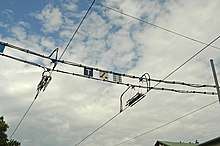
The old tram systems in London, Manhattan (New York City), and Washington, D.C., used live rails, like those on third-rail electrified railways, but in a conduit underneath the road, from which they drew power through a plough. It was called Conduit current collection. Washington's was the last of these to close, in 1962. Today, no commercial tramway uses this system. More recently, a modern equivalent to these systems has been developed which allows for the safe installation of a third rail on city streets, which is known as surface current collection or ground-level power supply; the main example of this is the new tramway in Bordeaux.
Ground-level power supply
A ground-level power supply system also known as Surface current collection or Alimentation par le sol (APS) is an updated version of the original stud type system. APS uses a third rail placed between the running rails, divided electrically into eight-metre powered segments with three metre neutral sections between. Each tram has two power collection skates, next to which are antennas that send radio signals to energize the power rail segments as the tram passes over them.
Older systems required mechanical switching systems which were susceptible to environmental problems. At any one time no more than two consecutive segments under the tram should actually be live. Wireless and solid state switching remove the mechanical problem.
Alstom developed the system primarily to avoid intrusive power supply cables in the sensitive area of the old city of old Bordeaux.[75]
Route
Route patterns vary greatly among the world's tram systems, leading to different network topologies.
- Most systems start by building up a strongly nucleated radial pattern of routes linking the city centre with residential suburbs and traffic hubs such as railway stations and hospitals, usually following main roads. Some of these, such as those in Hong Kong, Blackpool, Ulm and Bergen, still essentially comprise a single route. Some suburbs may be served by loop lines connecting two adjacent radial roads. Some modern systems have started by reusing existing radial railway tracks, as in Nottingham and Birmingham, sometimes joining them together by a section of street track through the city centre, as in Manchester. Later developments often include tangential routes linking adjacent suburbs directly, or multiple routes through the town centre to avoid congestion (as in Manchester's Second City Crossing.
- Other new systems, particularly those in large cities which already have well-developed metro and suburban railway systems, such as London and Paris, have started by building isolated suburban lines feeding into railway or metro stations. In Paris these have then been linked by ring lines.
- A third, weakly nucleated, route pattern may grow up where a number of nearby small settlements are linked, such as in the coal-mining areas served by BOGESTRA or the Silesian Interurbans.
- A fourth starting point may be a loop in the city centre, sometimes called a downtown circulator, as in Portland or El Paso.
- Occasionally a modern tramway system may grow from a preserved heritage line, as in Stockholm.
The resulting route patterns are very different. Some have a rational structure, covering their catchment area as efficiently as possible, with new suburbs being planned with tramlines integral to their layout – such is the case in Amsterdam. Bordeaux and Montpellier have built comprehensive networks, based on radial routes with numerous interconnections, within the last two decades. Some systems serve only parts of their cities, with Berlin being the prime example, owing to the fact that trams survived the city's political division only in the Eastern part. Other systems have ended up with a rather random route map, for instance when some previous operating companies have ceased operation (as with the tramways vicinaux/buurtspoorwegen in Brussels) or where isolated outlying lines have been preserved (as on the eastern fringe of Berlin). In Rome, the remnant of the system comprises 3 isolated radial routes, not connecting in the ancient city centre, but linked by a ring route. Some apparently anomalous lines continue in operation where a new line would not on rational grounds be built, because it is much more costly to build a new line than continue operating an existing one.
In some places, the opportunity is taken when roads are being repaved to lay tramlines (though without erecting overhead cables) even though no service is immediately planned: such is the case in Leipzigerstraße in Berlin, the Haarlemmer Houttuinen in Amsterdam, and Botermarkt in Ghent.
Tram systems operate across national borders in Basel (from Switzerland into France and Germany) and Strasbourg (From France into Germany). It is planned to open a line linking Hasselt (Belgium) with Maastricht (Netherlands) in 2021.
Track
Tramway track can have different rail profiles to accommodate the various operating environments of the vehicle. They may be embedded into concrete for street-running operation, or use standard ballasted track with railroad ties on high-speed sections. A more ecological solution is to embed tracks into grass turf.
Tramway tracks use a grooved rail with a groove designed for tramway or railway track in pavement or grassed surfaces (grassed track or track in a lawn). The rail has the railhead on one side and the guard on the other. The guard provides accommodation for the flange. The guard carries no weight, but may act as a checkrail. Grooved rail was invented in 1852 by Alphonse Loubat, a French inventor who developed improvements in tram and rail equipment, and helped develop tram lines in New York City and Paris. The invention of grooved rail enabled tramways to be laid without causing a nuisance to other road users, except unsuspecting cyclists, who could get their wheels caught in the groove. The grooves may become filled with gravel and dirt (particularly if infrequently used or after a period of idleness) and need clearing from time to time, this being done by a "scrubber" tram. Failure to clear the grooves can lead to a bumpy ride for the passengers, damage to either wheel or rail and possibly derailing.
In narrow situations double-track tram lines sometimes reduce to single track, or, to avoid switches, have the tracks interlaced, e.g. in the Leidsestraat in Amsterdam on three short stretches (see map detail); this is known as interlaced or gauntlet track. There is a UK example of interlaced track on the Tramlink, just west of Mitcham Station, where the formation is narrowed by an old landslip causing an obstruction. (See photo in Tramlink entry).
Track gauge
Historically, the track gauge has had considerable variations, with narrow gauge common in many early systems. However, most light rail systems are now standard gauge. An important advantage of standard gauge is that standard railway maintenance equipment can be used on it, rather than custom-built machinery. Using standard gauge also allows light rail vehicles to be delivered and relocated conveniently using freight railways and locomotives.
Another factor favoring standard gauge is that low-floor vehicles are becoming popular, and there is generally insufficient space for wheelchairs to move between the wheels in a narrow gauge layout. Standard gauge also enables – at least in theory – a larger choice of manufacturers and thus lower procurement costs for new vehicles. However, other factors such as electrification or loading gauge for which there is more variation may require costly custom built units regardless.
Tram stop
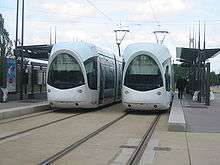

Tram stops may be similar to bus stops in design and use, particularly in street-running sections, where in some cases other vehicles are legally required to stop clear of the tram doors. Some stops may resemble to railway platforms, particularly in private right-of-way sections and where trams are boarded at standard railway platform height, as opposed to using steps at the doorway or low-floor trams.
Manufacturing
Approximately 5,000 new trams are manufactured each year. As of February 2017, 4,478 new trams were on order from their makers, with options being open for a further 1,092.[76]
The main manufacturers are:
| Manufacturer | Firm orders | Options |
|---|---|---|
| Bombardier | 962 | 296 |
| Alstom | 650 | 202 |
| Siemens | 557 | 205 |
| CAF | 411 | 112 |
| CRRC | 370 | 30 |
| PKTS/Metrovagonmash | 316 | |
| Kinkisharyo | 155 | 97 |
| Stadler-Vossloh | 189 | 25 |
| Stadler | 182 | 28 |
| Škoda Transtech | 104 | 47 |
| Škoda | 110 | |
| Durmazlar | 90 |
Debate
Advantages
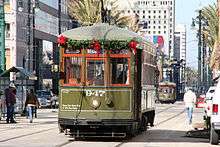
- Trams (and road public transport in general) can be much more efficient in terms of road usage than cars – one vehicle replaces about 40 cars (which take up a far larger area of road space).[77][78]
- Vehicles run more efficiently compared to similar vehicles that use rubber tyres, since the rolling resistance of steel on steel is lower than rubber on asphalt.[79]
- Being guided by rails means that even very long tram units can navigate tight, winding city streets that are inaccessible to long buses.
- Tram vehicles are very durable, with some being in continuous revenue service for more than fifty years. This is especially compared to internal combustion buses, which tend to require high amounts of maintenance and break down after less than 20 years, mostly due to the vibrations of the engine.
- In many cases tram networks have a higher capacity than similar buses. This has been cited as a reason for the replacement of one of Europe's busiest bus lines (with three-minute headways in peak times) with a tram by Dresdner Verkehrsbetriebe.
- Due to the abovementioned capacity advantage labor costs (which form the biggest share of operating costs of many public transit systems) per passenger can be significantly lower compared to buses
- Trams and light rail systems can be cheaper to install than subways or other forms of heavy rail. In Berlin the commonly cited figure is that one kilometer of subway costs as much as ten kilometers of tramway.
- Tramways can take advantage of old heavy rail alignments some examples include the Manchester Metrolink of which the Bury Line was part of the East Lancashire Railway. Other examples can be found in London, Boston, Melbourne and Sydney. They hence sometimes take advantage of high speed track while on train tracks.
- Tram networks can link to other operational heavy rail and rapid transit systems, allowing vehicles to move directly from one to the other without passengers needing to alight. Trams that are compatible with heavy rail systems are called tram-trains, while those that can use subway tunnels are called pre-metro or Stadtbahn.
- Passengers can reach surface stations quicker than underground stations. Subjective safety at surface stations is often seen to be higher.
- Trams can be tourist attractions in ways buses usually aren't.
- Many modern tram systems plant low growing vegetation - mostly grasses - between the tracks which has a psychological effect on perceived noise levels and the benefits of greenspace. This is not possible for buses as they deviate too much from an "ideal" track in daily operations
Disadvantages

- Tram tracks can be hazardous for cyclists, as bikes, particularly those with narrow tyres, may get their wheels caught in the track grooves.[80] It is possible to close the grooves of the tracks on critical sections by rubber profiles that are pressed down by the wheelflanges of the passing tram but that cannot be lowered by the weight of a cyclist. If not well-maintained, however, these lose their effectiveness over time.
- When wet, tram tracks tend to become slippery and thus dangerous for bicycles and motorcycles, especially in traffic.[80][81] In some cases, even cars can be affected.[82]
- The opening of new tram and light rail systems has sometimes been accompanied by a marked increase in car accidents, as a result of drivers' unfamiliarity with the physics and geometry of trams.[83] Though such increases may be temporary, long-term conflicts between motorists and light rail operations can be alleviated by segregating their respective rights-of-way and installing appropriate signage and warning systems.[84]
- Rail transport can expose neighbouring populations to moderate levels of low-frequency noise. However, transportation planners use noise mitigation strategies to minimise these effects.[85] Most of all, the potential for decreased private motor vehicle operations along the tram's service line because of the service provision could result in lower ambient noise levels than without.
By region

Trams are in a period of growth, with about 800 tram systems operating around the world, 10 or so new systems being opened each year, and many being gradually extended.[87] Some of these systems date from the late 19th or early 20th centuries. In the past 20 years their numbers have been augmented by modern tramway or light rail systems in cities that had discarded this form of transport. There have also been some new tram systems in cities that never previously had them.
Tramways with tramcars (British English) or street railways with streetcars (North American English) were common throughout the industrialised world in the late 19th and early 20th centuries but they had disappeared from most British, Canadian, French and US cities by the mid-20th century.[88]
By contrast, trams in parts of continental Europe continued to be used by many cities, although there were contractions in some countries, including the Netherlands.[89]
Since 1980 trams have returned to favour in many places, partly because their tendency to dominate the roadway, formerly seen as a disadvantage, is now considered to be a merit since it raises the visibility of public transport (encouraging car users to change their mode of travel), and enables streets to be reconfigured to give more space to pedestrians, making cites more pleasant places to live. New systems have been built in the United States, United Kingdom, Ireland, Italy, France, Australia and many other countries.
In Milan, Italy, the old "Ventotto" trams are considered by its inhabitants a "symbol" of the city. The same can be said of trams in Melbourne in general, but particularly the iconic W class. The Toronto streetcar system had similarly become an iconic symbol of the city, operating the largest network in the Americas as well as the only large-scale tram system in Canada (not including light rail systems, or heritage lines).[90][91]
Major tram and light rail systems
Current systems
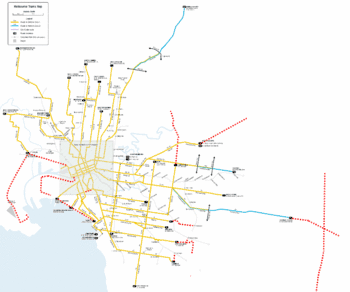
The largest tram ((classic tram, streetcar, straßenbahn) and fast tram (light rail, stadtbahn)) networks in the world by route length (as of 2016)[92] are:
- Melbourne (256 km; 159 mi)[93]
- Kiev (230 km; 140 mi)[94]
- Kharkiv[94]
- Saint Petersburg (205.5 km; 127.7 mi)[95]
- Odessa (197 km; 122 mi)[94]
- Cologne(194.8 km; 121.0 mi)[96][97]
- Berlin (191.6 km; 119.1 mi)[98]
- Moscow (183 km; 114 mi)[99]
- Milan (181.8 km; 113.0 mi)[100]
- Budapest (172 km; 107 mi)[101]
- Dnipro (172 km; 107 mi)[94]
- Katowice agglomeration (171 km; 106 mi)[102]
- Vienna (170 km; 110 mi).[103]
Other large transit networks that operate streetcar and light rail systems include:
- Dallas Light Rail,[104] modern streetcar[105] and heritage streetcar[106] (155 km; 96 mi)
- Sofia (153.6 km; 95.4 mi)[92]
- Leipzig (148.3 km; 92.1 mi)[107]
- Brussels (147.1 km; 91.4 mi)[108]
- Łódź (145 km; 90 mi)[109]
- Bucharest (143 km; 89 mi)[110]
- Prague (142.4 km; 88.5 mi)[111]
- Warsaw (138 km; 86 mi)
- Dresden (134 km; 83 mi)
- Los Angeles (133.1 km; 82.7 mi)[112]
- Bonn Stadtbahn and streetcars (125.32 km; 77.87 mi)
- Stuttgart (124.5 km; 77.4 mi)[113]
- Hanover (121 km; 75 mi), Zagreb (116.3 km; 72.3 mi)
- Bremen (114.6 km; 71.2 mi)
- Portland metropolitan area light rail and streetcars (108.2 km; 67.2 mi)
- Paris (104.9 km; 65.2 mi)[114]
- Mannheim/Ludwigshafen (103.4 km; 64.2 mi)[115][116]
- Riga (99.52 km; 61.84 mi)
- Gothenburg (95 km; 59 mi)
- Kassel (93.3 km; 58.0 mi)
- Manchester (92.5 km; 57.5 mi)
- Dnipro (87.8 km; 54.6 mi)
- Halle (Saale) (87.6 km; 54.4 mi)
- San Diego (86.1 km; 53.5 mi)
- Pavlodar (86 km; 53 mi)[117]
- Turin (84 km; 52 mi)
- Bochum/Gelsenkirchen (84 km; 52 mi)
- Zurich (84 km; 52 mi)[118]
- Toronto (83 km; 52 mi)[119]
- Amsterdam (80.5 km; 50.0 mi)[120]
- Munich (79 km; 49 mi)[121]
- Antwerp (79 km; n49 mi)[122]
- Denver (76 km; 47 mi)
- Iași (76 km; 47 mi)
- Salt Lake Valley light rail and streetcar (75.42 km (46.86 mi))
- Dortmund (75 km; 47 mi)
- Rotterdam (75 km; 47 mi)[123] St. Louis Metropolitan Area (74 km; 46 mi)
- Lviv (73.5 km; 45.7 mi)
- Mykolaiv (72.83 km; 45.25 mi)
- Karlsruhe (71.5 km; 44.4 mi)
- Brno (70.4 km; 43.7 mi)
- Porto (70 km; 43 mi)
- Sacramento (69 km; 43 mi)[124]
- Frankfurt am Main (68 km; 42 mi)
- San Jose and its suburbs (67.9 km; 42.2 mi)
- Lyon (66.3 km; 41.2 mi)[125]
- Ostrava (65.7 km; 40.8 mi)
- Basel (65.7 km; 40.8 mi)
- Donetsk (65.7 km; 40.8 mi)
- Poznań (65.6 km; 40.8 mi)
- Minsk (62.8 km; 39.0 mi)
- Shenyang (62 km; 39 mi)
- Szczecin (60 km; 37 mi)
- Graz (59.8 km; 37.2 mi)
- Montpellier (55.6 km; 34.5 mi)[126][127]
- Pyongyang (53.5 km; 33.2 mi) Essen (52.4 km; 32.6 mi)
- Gdańsk (52.2 km; 32.4 mi).
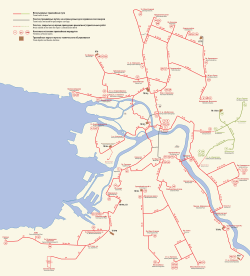
Statistics
- Tram and light rail systems operate in 388 cities across the world, 206 of which are in Europe;
- The longest single tram line in the world is the 68 km (42 mi) Belgian Coast Tram, which runs almost the entire length of the Belgian coast. Another fairly long line is the Valley Metro Rail in Phoenix, Arizona, with its 42 km (26 mi).[128][129]
- Since 1985, 120 light rail systems have opened;
- Since 2000, 78 systems have opened while 13 have closed. The countries that have opened the most systems since 2000 are the USA (23), France (20), Spain (16), and Turkey (8);
- 15,618 km (9,705 mi) of track is in operation, with 850 km (530 mi) in construction and a further 2,350 km (1,460 mi) planned;
- The longest systems are in Melbourne (254 km or 158 mi), Saint Petersburg (228 km or 142 mi), Katowice (Upper Silesian Industrial Region) (200 km or 120 mi), Cologne (193 km or 120 mi), Berlin (192 km or 119 mi), Milan (182 km or 113 mi), Budapest (172 km or 107 mi), and Vienna (170 km or 110 mi).
- These lines have 32,345 stops at an average spacing of 484 metres;
- They carry 13.5 billion passengers a year, 3% of all public transport passengers. The highest-volume systems are Budapest (396 million passengers a year), Prague (372 m),[130] Bucharest (322 m), Saint Petersburg (312 m), and Vienna (305 m);
- The most intensely used networks (passengers per km of, per year) are: Istanbul, Hong Kong, Tokyo and Sarajevo.
- Just over 36,000 trams and light rail vehicles are in operation. The largest fleets are in Moscow (919), Saint Petersburg (833), Prague (830),[130] Budapest (612) and Warsaw (526);
- Between 1997 and 2014, 400–450 vehicles have been built per year.
- As of October 2015, Hong Kong has the world's only exclusively double-decker tramway system.[131]
- The most intensively used junction in any tram network is the Lazarská x Spálená junction in Prague with appx. 150 vehicles passing through per hour.[132]
Historical
Historically, the Paris Tram System was, at its peak, the world's largest system, with 1,111 km (690 mi) of track in 1925 (according to other sources, ca. 640 km (400 mi) of route length in 1930). However it was completely closed in 1938.[133] The next largest system appears to have been 857 km (533 mi), in Buenos Aires before 19 February 1963. The third largest was Chicago, with over 850 km (530 mi) of track,[134] but it was all converted to trolleybus and bus services by 21 June 1958. Before its decline, the BVG in Berlin operated a very large network with 634 km (394 mi) of route. Before its system started to be converted to trolleybus (and later bus) services in the 1930s (last tramway closed 6 July 1952), the first-generation London network had 555 km (345 mi) of route in 1931.[135] In 1958 trams in Rio de Jainero were employed on (433 km; 269 mi) of track. The final line, the Santa teresa route was closed in 1968.[136] During a period in the 1980s, the world's largest tram system was in Leningrad (now known as St. Petersburg) with 350 km (220 mi), USSR, and was included as such in the Guinness World Records; however Saint Petersburg's tram system has declined in size since the fall of the Soviet Union. Vienna in 1960 had 340 km (211 mi), before the expansion of bus services and the opening of a subway (1976). Substituting subway services for tram routes continues. 320 km (199 mi) was in Minneapolis-Saint Paul in 1947: There streetcars ended 31 October 1953 in Minneapolis and 19 June 1954 in St. Paul.[137] The Sydney tram network, before it was closed on 25 February 1961, had 291 km (181 mi) of route, and was thus the largest in Australia. As from 1961, the Melbourne system (currently recognised as the world's largest) took over Sydney's title as the largest network in Australia.
Indonesia
- In Batavia (now Jakarta), the capital of the former Dutch colony of the Netherlands East Indies, a horse tram service started in 1869. A steam tram ran from 1881, and electrification followed in 1897. All Jakarta trams were discontinued in the 1960s by an independent Indonesia due to pressure from Sukarno, which saw tram network as "antiquated" and a "relic of [the] colonial era". The other cities in Indonesia who used to have urban tram network were Surabaya and Semarang.
- The Semarang tram network was constructed between 1882 and 1883, and it was essentially an inner suburb extension of the Samarang Joana Railway (SJS) network. The company already had an extensive rural tram network to the east of Semarang. Unfortunately, due to financial difficulties that hampered the SJS railway company, the Semarang tram network was closed down in 1940 (despite public protest in Semarang) and their rolling stock transferred to the Surabaya tram network.
- Surabaya's tram network was first built in 1886. Initially consisting of steam trams only, later electric trams were added in 1923. They served Surabaya commuters well into the independence era. The electric tram bowed out from service in 1968, while its steam counterpart outlived the electrics before they too bowed out from service in 1978, making it the very last urban steam tram service in the world to go out of service.
- In 2012, there was talk of reviving Surabaya's tram network as a part of Surabaya Mass Rapid Transit project, which will see parts of the old electric tram right of way reactivated, and it will be combined with the future monorail network. The project is aimed to alleviate Surabaya's traffic congestion and provide cheap public transportation for Surabaya commuters. In 2014, the project entered the tender phase.
Africa
Asia
- Tramway systems were well established in the Asian region at the start of the 20th century, but started a steady decline during the mid to late 1930s. The 1960s marked the end of its dominance in public transportation with most major systems closed and the equipment and rails sold for scrap; however, some extensive original systems still remain in service in Japan. In recent years there has been renewed interest in the tram with modern systems being built in Japan and China.
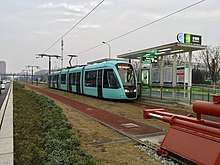
- Several cities in China had tram systems during the 20th century; however, by the end of the century, only the systems in Dalian, Hong Kong and Changchun remained extant. However the 21st century has seen a resurgence in development of tram transport as China struggles with urban traffic congestion and pollution with at least 15 systems operating. Hong Kong has an exclusive fleet of double-decker trams. As of 2019, Wuyishan, Baoshan, Jiaxing and Haikou have new tram systems under construction.
- The first Japanese tram line was inaugurated in 1895 as the Kyoto Electric Railroad. The tram reached its zenith in 1932 when 82 rail companies operated 1,479 kilometers of track in 65 cities. The tram declined in popularity through the remaining years of the 1930s and during the 1960s many of the remaining operational tramways were shut down or converted into commuter railway lines.
- In India, trams are in operation only in Kolkata and gauge up to 30 km across the city. Trams were discontinued in Chennai in 1954 and in Mumbai in 1960.[138]
- The Northern and Central areas of the City of Colombo in Sri Lanka had an electric Tram Car system (3 ft 6 in or 1,067 mm gauge). This system commenced operations about 1900 and was discontinued by 1960. However, a new tram system is in the process of being brought to Colombo as part of the plan of Western Region Megapolis.
- The 13-kilometre-long Jerusalem Light Rail system began operation in August 2011 and is currently being extended, with the full system expected to be in operation by 2023. A significant portion of it will be underground. A light rail system for Beersheba is also currently planned.
- In Thailand, an extensive tram system ran in Bangkok from 1888, until it was suspended in 1968. A smaller single-route tram route tram in Lopburi was also suspended in the early 1960s.
- Other countries with discontinued tram systems include Indonesia, Singapore, Malaysia, Pakistan, Philippines, and Vietnam.
- However, a tram system is planned for construction in Gwadar, Pakistan where construction started in late 2011.
- Trams are also under construction in DHA City, Karachi.
Europe
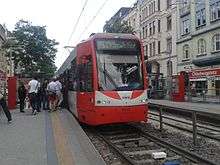
In many European cities, much tramway infrastructure was lost in the mid-20th century, though not always on the same scale as in other parts of the world such as North America. Most of Central and Eastern Europe retained the majority of its tramway systems and it is here that the largest and busiest tram systems in the world are found.
Whereas most systems and vehicles in the tram sector are found in Central and Eastern Europe, in the 1960s and 1970s, tram systems were shut down in many places in Western Europe, however urban transportation has been experiencing a sustained long running revival since the 1990s. Many European cities are rehabilitating, upgrading, expanding and reconstructing their old tramway lines and building new tramway lines.[139]
North America

In North America, these vehicles are called "streetcars" (or "trolleys"); the term tram is more likely to be understood as an aerial tramway or a people-mover. Streetcar systems were developed in late 19th to early 20th centuries in a number of cities throughout North America. However, most North American cities saw its streetcar lines removed in the mid-20th century for a variety of financial, technological and social reasons. Exceptions included Boston,[140] Cleveland, Mexico City, New Orleans, Newark, Philadelphia, Pittsburgh, San Francisco, and Toronto.
Canada
Toronto currently operates the largest streetcar system in the Americas in terms of track length and ridership. Operated by the Toronto Transit Commission, the streetcar system is the only large-scale streetcar system existing in Canada, excluding heritage streetcar, or light rail systems that are operated in other Canadian municipalities. The streetcar system was established in 1861, and used a variety of vehicles in its history, including horse-drawn streetcars, Peter Witt streetcars, the PCC streetcar, and the Canadian Light Rail Vehicle and its articulated counterpart, the Articulated Light Rail Vehicle. Since December 29, 2019,[141] the system exclusively uses the Flexity Outlook made by Bombardier Transportation.[142][143][144][145]
Streetcars once existed in the Canadian cities of Calgary, Edmonton, Halifax, Hamilton, Kingston, Kitchener, London, Montreal, Ottawa, Peterborough, Quebec City, Regina, Saskatoon, Windsor, and Vancouver. However, Canadian cities excluding Toronto, removed their streetcar systems in the mid-20th century. In the late 1970s and early 1980s, light rail systems were introduced in Calgary and Edmonton; with another light rail system established in Ottawa in 2001. There is now something of a renaissance for light railways in mid-sized cities with Waterloo, Ontario the first to come on line and construction underway in Mississauga, Ontario. In the late 20th century, several Canadian locales restored portions of their defunct streetcar lines, operating them as a heritage feature for tourists. Heritage streetcar lines in Canada include the High Level Bridge Streetcar in Edmonton, the Nelson Electric Tramway in Nelson, and the Whitehorse Waterfront Trolley in Whitehorse.
United States of America
.jpg)
Pittsburgh had kept most of its streetcar system serving the city and many suburbs, making it the longest-lasting large-network streetcar system in the United States. However, most of Pittsburgh's surviving streetcar lines were converted to light rail in the 1980s. San Francisco's Muni Metro system is the largest surviving streetcar system in the United States, and has even revived previously closed streetcar lines such as the F Market & Wharves heritage streetcar line. In the late 20th century, several cities installed modern light rail systems, in part along the same corridors as their old streetcars systems, the first of these being the San Diego Trolley in San Diego in 1981.
In the 1980s, some cities in the United States brought back streetcars lines, including Memphis, Tampa, and Little Rock; However, these streetcar systems were designed as heritage streetcar lines, and used vintage or replica-vintage vehicles. The first "second-generation streetcar systems" in North America was opened in Portland in 2001.[146] The "second-generation streetcar system," utilizes modern vehicles – vehicles that feature low-floor streetcars. These newer streetcar systems were built in several American cities in the early 21st century including Atlanta, Charlotte, Cincinnati, Dallas, Detroit, Kansas City, Milwaukee, Oklahoma City, Seattle, Tucson, and Washington, D.C..
Oceania

Australia
- Historically, there have been trams in the following Australian cities and towns: Adelaide, Ballarat, Bendigo, Brisbane, Broken Hill, Fremantle, Gawler, Geelong, Hobart, Kalgoorlie, Launceston, Leonora, Maitland, Melbourne, Moonta–Wallaroo, Newcastle, Perth, Rockhampton, Sorrento, Sydney, and Victor Harbor. These ranged from extensive systems to single lines.
- The Sydney system, which closed in 1961, was the most extensive and the largest passenger carrier of any Australian public transport system then or since, moving over 400 million passengers per annum, at its peak.
- Virtually all known types of motive power have been utilised at some stage, in Australia.
- Today, trams can be found in Melbourne (by length, the world's largest system), and to a lesser extent, Adelaide; all other major cities having largely dismantled their networks by the 1970s.
- Sydney reintroduced tram services in 1997 on a modern light rail network, while Ballarat and Bendigo retained their trams as heritage systems. In 2008 and 2009, Bendigo trialled using its heritage trams for regular public transport.
- Portland, Victoria, introduced a tourist tram line in 1996, which uses two replicas of a Melbourne cable car dummy or grip car, driven by a hidden diesel motor, and two restored trailer cars.
- A completely new public transport system opened on the Gold Coast, Queensland on 20 July 2014, with a major extension completed in December 2017. The new system is known as the G:link and is the first tram/light rail system in the state of Queensland since Brisbane closed its tram network in 1969.
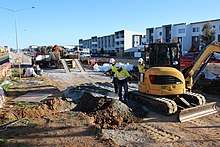
- The 2010s has also seen a significant expansion of Sydney's network, while the construction of light rail in Canberra became the major issue of the 2016 ACT election, with the ruling parties supporting the project and the opposition opposing it. The government was returned[147] and Stage 1 of the light rail launched in April 2019.[148]
- The railway into the centre of Newcastle was truncated to Wickham on 25 December 2014,[149][150] The railway line was replaced by the Newcastle Light Rail line in February 2019.
- There are also loose plans for new systems in Hobart, Tasmania, and on the Sunshine Coast, Queensland.
New Zealand
- New Zealand's last public transport tramway system, that of Wellington, closed in 1966.
- Nevertheless, there had been tramways ranging from large, comprehensive systems to single lines, in Auckland, Christchurch, Dunedin, Gisborne, Invercargill, Napier, New Plymouth, Greymouth, Westport, Hokitika, Ross, Brighton, Charleston, Kamiere and Kamara.
- New Zealand's tram gauges were not standardised; the 15 systems used no less than five gauges, making swapping of rolling stock from system to system difficult.[151]
- Christchurch has subsequently reintroduced heritage trams over a new CBD route, but the overhead wiring plus some track was damaged by the earthquake of 2011. In November 2013, a limited circuit was reopened.
- Auckland has recently introduced heritage trams into the Wynyard area, near the CBD, using former Melbourne trams. On 9 May 2018, two modern tram/Light rail routes were announced from Wynyard Quarter, via Queen Street to Auckland Airport via Dominion Road and Onehunga in the South and via Queen Street and Great North Road, Point Chevalier and onto the Northwestern Motorway to Westgate to be running in the early 2020s with a possible further extension to Kumeu/Huapai.
- Preserved Auckland trams from the MOTAT have made cameo appearances during Heritage Weeks.
- Heritage lines exist at Auckland's MOTAT, the Wellington Tramway Museum at Queen Elizabeth Park on the Kapiti Coast, the Tramways Trust Wanganui and the Tramway Historical Society at Ferrymead in Christchurch, as well as the Christchurch Tramway Limited in the central city.
- Whangarei Steam and Model Railway Club also run two former Lisbon trams formally from Aspen, Colorado.
South America
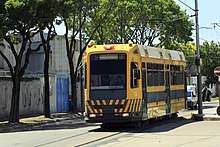
- Buenos Aires in Argentina once had one of the most extensive tramway networks in the world with over 857 km (533 mi) of track, most of it dismantled during the 1960s in favour of bus transportation. A new line, the PreMetro line E2 system feeding the Line E of the Buenos Aires Subway has been operating since 1987 on the outskirts of Buenos Aires.
- In Cuenca, Ecuador, a tram line started operating since March 2019 as the main public transportation system in the city. The L1 of the Cuenca tram is 20.4 km long with 20 stops and uses Alstom Citadis (302) trains.
- A historic tram line known as the Santa Teresa Tram operates in Rio de Janeiro, Brazil.
- The Tranvía del Este in Puerto Madero, Buenos Aires, operated from 2007 to 2012, and it is now dismantled.[152]
- Also in the city of Mendoza, in Argentina, a new tramway system is currently on service since 2012, the Metrotranvía of Mendoza, which will have a route of 12.5 km (7.8 mi) and will link five districts of the Greater Mendoza conurbation.[153]
- In Medellín, Colombia, a tram line began operation on 15 October 2015,[154][155] as a revival of old Ayacucho tram.[156]
- In Santiago, Chile there are plans for a tramway that will connect the comunes of Las Condes, Lo Barnechea y Vitacura. (tranvía de Las Condes)
Incidents
- In January 1864, well-known Anglo-Australian musician and composer Isaac Nathan was hit and killed by a Sydney horse tram when his clothing was caught in the door, whilst he was attempting to alight. Nathan is reputed to be one of the first tram fatalities in the Southern Hemisphere (many sources claim that it was the first such accident).[157][158]
- On the morning of 18 August 1901, four masked men, described as "urban bushrangers", held up an eastbound horse tram in Riversdale Road, Melbourne, just past Power Street. For their trouble the men received £2.10.0 in fares from driver Thomas Taylor, and £21.19.0 from eight passengers. One passenger was injured. The bandits were never caught. Contemporary newspapers hypothesised that the bandits were after a specific commuter who travelled regularly on this particular tram and who was in the habit of carrying large amounts of cash.[159][160]
- In the Tottenham Outrage in 1909, two armed robbers hijacked a tram and were chased by the police in another tram.[161]
- On 7 June 1926 Catalan architect Antoni Gaudí was knocked down by a Barcelona tram and subsequently died.[162]
- On 27 February 1930, Paul de Vivie (pen name Vélocio), godfather of the dérailleur was killed by a tram in St Étienne[163]
- It is reputed[164] that in the 1930s a murdered body was dragged out of the River Thames in London. The body had been stripped of anything that might have identified him. The only clue to the person's identity was a portion of a tram ticket hidden in the lining of his coat. The local police did not recognise the ticket but images in newspapers led to it being identified as a Melbourne tram ticket. Serendipitously, the serial number on the ticket was intact. Victoria Police in Melbourne, acting as agents for the Metropolitan Police in London, contacted the Melbourne & Metropolitan Tramways Board. From the serial number, the M&MTB were able to tell which tram depot had issued the ticket, on what day and on which specific tram, and in which section of a particular route (North Balwyn). Police then interviewed regular commuters and discovered the identity of a man whom, they believed, had recently travelled to London. This led to the arrest and conviction of the murderer. Decades after the event, the M&MTB were still citing the incident in training courses as a reason for tram conductors, etc., to keep proper and efficient records.
In popular culture
Tram modelling
Model trams are popular in HO scale (1:87) and O scale (1:48 in the US and generally 1:43,5 and 1:45 in Europe and Asia). They are typically powered and will accept plastic figures inside. Common manufacturers are Roco and Lima, with many custom models being made as well. The German firm Hödl[165] and the Austrian Halling[166] specialise in 1:87 scale.[167]
In the US, Bachmann Industries is a mass supplier of HO streetcars and kits. Bowser Manufacturing has produced white metal models for over 50 years.[168] There are many boutique vendors offering limited run epoxy and wood models. At the high end are highly detailed brass models which are usually imported from Japan or Korea and can cost in excess of $500. Many of these run on 16.5 mm (0.65 in) gauge track, which is correct for the representation of 4 ft 8 1⁄2 in (1,435 mm) (standard gauge) in HO scale as in US and Japan, but incorrect in 4 mm (1:76.2) scale, as it represents 4 ft 8 1⁄2 in (1,435 mm). This scale/gauge hybrid is called OO scale. O scale trams are also very popular among tram modellers because the increased size allows for more detail and easier crafting of overhead wiring. In the US these models are usually purchased in epoxy or wood kits and some as brass models. The Saint Petersburg Tram Company[169] produces highly detailed polyurethane non-powered O Scale models from around the world which can easily be powered by trucks from vendors like Q-Car.[170]
In the US, one of the best resources for model tram enthusiasts is the East Penn Traction Club of Philadelphia [171] and Trolleyville a website of the Southern California Traction Club.[172]
It is thought that the first example of a working model tramcar in the UK built by an amateur for fun was in 1929, when Frank E. Wilson created a replica of London County Council Tramways E class car 444 in 1:16 scale, which he demonstrated at an early Model Engineer Exhibition. Another of his models was London E/1 1800, which was the only tramway exhibit in the Faraday Memorial Exhibition of 1931. Together with likeminded friends, Frank Wilson went on to found the Tramway & Light Railway Society[173] in 1938, establishing tramway modelling as a hobby.
See also
Tram types
- A class Melbourne tram
- ADtranz low floor tram
- B-class Melbourne tram
- AKSM
- ATM Class 1500
- ATM Class 4600 and 4700
- Avanto
- Birney
- C-class Melbourne tram
- California car
- Citytram
- Combino
- Crotram
- D-class Melbourne tram
- Dick Kerr Type Tram
- E-class Melbourne tram
- F-class Melbourne tram
- DL
- Double-decker tram
- Socimi Eurotram
- Bombardier Flexity
- Gothawagen
- Gelede Tram Lang
- H type Adelaide tram
- Bombardier Incentro
- K-1 (tram)
- Konstal
- PESA
- Sirio
- Silkworm tram, Bursa, Turkey
- SL95
- Soviet/Latvian RVR
- Soviet/Russian tramcars LM/LVS, MTV, КТМ, Spektr
- Škoda ForCity etc.
- AnsaldoBreda T-68
- AnsaldoBreda T-69
- Tatra KT4
- TMK 2200
- Tramino
- Tramway Français Standard
- TW 6000
- Ultra Low Floor
- Urbos
- US Standard Light Rail Vehicle
- Variotram
- Z-class Melbourne tram
- Zwevend Geleed Tramrijtuig, Rotterdam, Netherlands
Trams by region
Other topics
- Armoured tram
- Capabus
- Cater MetroTrolley
- Dual-mode transit
- List of town tramway systems
- List of tram and light rail transit systems
- List of tram builders
- List of tram systems by gauge and electrification
- List of transport museums
- Minecart, also known as a tram
- Premetro
- Rail transport in Walt Disney Parks and Resorts
- Railway electrification system
- Streetcar suburb
- Toronto PCC
- Tram and light rail transit systems
- TRAM EM - European Tramdriver Championship[174]
- Tram stop
- Trams in popular culture
- Trams and roundabouts
References
- "tram – definition". The Free Dictionary. Retrieved 19 February 2018.
- "Tram – Definition and More from the Free Merriam-Webster Dictionary". merriam-webster.com. Archived from the original on 9 April 2015.
- Collins English Dictionary – Complete and Unabridged, 12th Edition 2014 © HarperCollins Publishers 1991, 1994, 1998, 2000, 2003, 2006, 2007, 2009, 2011, 2014
- "tram, n.2". A Dictionary of the Older Scottish Tongue (up to 1700). Dictionary of the Scots Language.
- Duden-das Herkunftswörterbuch-Etymologie der deutschen Sprache-Mannheim 2001 p859
- "Online Etymology Dictionary". Etymonline.com. Archived from the original on 10 May 2015. Retrieved 8 March 2015.
- Robert C. Post (2007). Urban Mass Transit: The Life Story of a Technology. Greenwood Publishing Group. p. 43. ISBN 978-0-313-33916-5.
- "Online Etymology Dictionary". etymonline.com. Archived from the original on 12 September 2015.
- Middleton, William D. (1967). The Time of the Trolley, p. 60. Milwaukee: Kalmbach Publishing. ISBN 0-89024-013-2.
- "The Swansea and Mumbles Railway – the world's first railway service". Welshwales.co.uk. Archived from the original on 26 June 2007. Retrieved 8 March 2015.
- Dunbar 1967, p. 15.
- Dunbar 1967, p. 23.
- Dunbar 1967, pp. 16–17.
- The John Stephenson Car Co. Retrieved 25 February 2009.
- Dunbar 1967, p. 18.
- Dunbar 1967, p. 21.
- "Transportation Technology". www.siemens.com. Archived from the original on 29 July 2016. Retrieved 21 January 2018.
- "The Cable Car Home Page – Miscellaneous Newspaper Articles". www.cable-car-guy.com.
- "Sulphur Rock Street Car; Encyclopedia of Arkansas History & Culture". Retrieved 23 December 2008.
- Allen Morrison. "The Indomitable Tramways of Celaya". Retrieved 22 December 2008.
- "1876 – 1964 (Überblick)". Archived from the original on 24 February 2011. Retrieved 8 March 2015.
- "Cinquant'anni fa Milano diceva addio al "Gamba de legn"". Retrieved 10 February 2019.
- Robertson, Andrew (March 1848). "Blackwall Railway Machinery". The Civil Engineer and Architect's Journal. New York: Wiley & Putnam. 11.
- The Bowery boys : adventures In Old New York : an unconventional exploration of Manhattan's historic neighborhoods, secret spots and colorful characters. Ulysses Press. 18 April 2016. p. 179. ISBN 1612435769.
- Trams in Sydney
- "WEDNESDAY, DECEMBER 29, 1886". The Argus. Melbourne. 29 December 1886. p. 5. Retrieved 10 March 2013 – via National Library of Australia.
- "Australian Timetable Association". austta.org.au. 10 August 2012. Retrieved 8 December 2012.
- "mark the fitter: November 2008". Markthefitter.blogspot.com. 17 November 2008. Retrieved 8 March 2015.
- "Google". www.google.com.au. Archived from the original on 30 December 2012. Retrieved 22 July 2019.
- "Cieplice lšskie Zdrój is one of the best known Silesian towns". Archived from the original on 29 September 2006. Retrieved 8 March 2015.
- "Malaysia: first compressed natural gas tram in the world will be ready next year". www.ngvjournal.com. 22 February 2011. Archived from the original on 28 March 2012. Retrieved 27 July 2011.
- C. N. Pyrgidis. Railway Transportation Systems: Design, Construction and Operation. CRC Press, 2016. P. 156
- Ye. N. Petrova. St. Petersburg in Focus: Photographers of the Turn of the Century; in Celebration of the Tercentenary of St. Petersburg. Palace Ed., 2003. P. 12
- Guarnieri, M. (2020). "Electric tramways of the 19th century". IEEE Industrial Electronics Magazine. 14 (1): 71–77. doi:10.1109/MIE.2020.2966810.CS1 maint: ref=harv (link)
- Hearst Magazines (May 1929). "Popular Mechanics". Popular Mechanics. Hearst Magazines. p. 750.
- "Blackpool Trams". Fylde Tramway Society. 3 September 2004. Archived from the original on 17 July 2011. Retrieved 19 November 2010.
- American Public Transportation Association. "Milestones in U.S. Public Transportation History". Archived from the original on 3 March 2009. Retrieved 20 March 2013.
- Wood, E. Thomas. "Nashville now and then: From here to there". Archived from the original on 28 September 2007. Retrieved 7 August 2007.
- Kaempffert & Martin 1924, pp. 122–123.
- Hammond 2011, p. 142.
- "Professor Sidney Howe Short experiments with motors". Fort Worth Daily Gazette. Fort Worth, Texas. 11 November 1894 – via Newspapers.com

- "Sidney Howe Short". Grace's Guide to British Industrial History. Grace's Guide Ltd. Archived from the original on 12 March 2017. Retrieved 10 March 2017.
- "Street Railways his hobby". Topeka Daily Capital. Topeka, Kansas. 14 November 1894 – via newspapers.com

- Malone 1928, p. 128.
- "Sarajevo Official Web Site : Sarajevo through history". Sarajevo.ba. 29 June 1914. Archived from the original on 23 October 2014. Retrieved 8 March 2015.
- "City of Belgrade – Important Years in City History". Beograd.org.rs. 5 October 2000. Archived from the original on 11 January 2015. Retrieved 8 March 2015.
- "Trams of Hungary and much more". Hampage.hu. Archived from the original on 2 March 2015. Retrieved 8 March 2015.
- "RATB – Regia Autonoma de Transport Bucureşti". Ratb.ro. Archived from the original on 18 March 2015. Retrieved 8 March 2015.
- "Historical Highlights". Ljubljanski potniški promet [Ljubljana Passenger Transport]. Archived from the original on 4 March 2012. Retrieved 25 April 2012.
- Fasting, Kåre: Sporveier i Oslo gjennom 100 år. AS Oslo Sporveier, Oslo 1975, pp. 49-50.
- Green, Robert (1989). The first electric road : a history of the Box Hill and Doncaster tramway. East Brighton, Victoria: John Mason Press. ISBN 0731667158.
- Innovation in the world’s largest tram network Rail Express 5 May 2020
- Division, Infrastructure. "City Tram Extension". dpti.sa.gov.au. Retrieved 22 July 2019.
- Light rail in Newcastle opening from Monday 18 February Transport for NSW 3 February 2019
- "Routes for Light Rail". Archived from the original on 2 April 2019. Retrieved 22 July 2019.
- Kyoto Tram from Kyoto City Web. Retrieved 12 February 2009.
- The Rebirth of Trams from the JFS Newsletter, December 2007. Retrieved 12 February 2009.
- "Tokyo in Transit: Japanese Culture on the Rails and Road". books.google.com. Retrieved 4 May 2020.
- "The Rebirth of Trams: The Promise of Light Railway Transit (LRT)". Retrieved 19 April 2020.
- Wordpress.com Archived 29 January 2009 at the Wayback Machine, "The transport politic"
- David E. Nye (1992). Electrifying America: Social Meanings of a New Technology, 1880–1940. MIT Press. p. 86. ISBN 978-0-262-64030-5.
- Thomas Davenport from the Hebrew University of Jerusalem Archived 16 October 2008 at the Wayback Machine. Retrieved 14 February 2009.
- UK, DVV Media. "Battery trams running in Nanjing". Railway Gazette. Archived from the original on 14 January 2018. Retrieved 2 June 2016.
- de:Druckluftstrassenbahn Bern
- "Taranna - Tasmania". The Sydney Morning Herald. Fairfax Media. 8 February 2014. Retrieved 23 February 2018.
- "Local History - History of the Tasman Peninsula". Tasman Council. Retrieved 4 July 2015.
- "Port Arthur Historic Sites Statutory Management Plan 2008". UNESCO. Retrieved 5 July 2015.
- Robert Hughes (1987). The Fatal Shore. Random House. pp. 407–408. ISBN 9781407054070. Retrieved 5 July 2015.
- "Taranna - Tiny township on the road to Port Arthur". The Age. Fairfax Media. 8 February 2004. Retrieved 4 July 2015.
- John Yonge, Australian Railway Atlas: No.1 -Tasmania, Quail Map Company, Exeter U.K., 2004
- "China Presents the World's First Hydrogen-Fueled Tram".
- "China Develops World's First Hydrogen-Powered Tram". IFLScience.
- "Portland Tram – Google Search". Google.com.au. Retrieved 8 March 2015.
- "An Introduction To Capacitors". Facstaff.bucknell.edu. Archived from the original on 9 March 2015. Retrieved 8 March 2015.
- Allez le Tram from Railway-Technology.com. Retrieved 15 February 2009.
- Mike Taplin, Tramways and Urban Transit no. 952, April 2017, 0. 131
- "Human Transit". Archived from the original on 31 March 2015.
- "Special Report 257: Making Transit Work" (PDF). Archived (PDF) from the original on 8 August 2017. Retrieved 12 March 2017.
- "Why are trams different from buses from Trams for Bath". Bathtram.org. Archived from the original on 8 June 2013. Retrieved 8 December 2012.
- "Crossing tram tracks – Bicycle Network". Bv.com.au. 14 July 2004. Archived from the original on 31 March 2012. Retrieved 8 December 2012.
- "Trams/Light Rail – Road Safety Authority Rules of the Road". Rulesoftheroad.ie. Archived from the original on 29 November 2007. Retrieved 8 December 2012.
- Andrew Heasley (29 April 2004). "Slippery issue on track". The Sydney Morning Herald.drive.com.au. Archived from the original on 8 November 2012. Retrieved 8 December 2012.
- Charles S. McCaleb, Rails, Roads & Runways: The 20-Year Saga of Santa Clara County's Transportation Agency, (San Jose: Santa Clara County Transportation Agency, 1994), 67. Besides recounting statistics and anecdotes, this source also reprints a San Jose Mercury News cartoon of one such accident, in which a bemused tow truck driver quips, "Dang! Rod Diridon was right! The trolley does reduce the number of vehicles on the road!"
- "Light Rail Service: Pedestrian and Vehicular Safety | Blurbs | Main". Trb.org. 30 March 2014. Archived from the original on 1 June 2008. Retrieved 8 March 2015.
- "Wheel/Rail Noise Control Manual | Blurbs | Main". Trb.org. Archived from the original on 1 June 2008. Retrieved 8 March 2015.
- www.urbanrail.net
- Tramways and Urban Transit No. 956, August 2017, p. 301
- Jeffrey Spivak: Streetcars are back from Landscape Architecture Department, UC Davis Archived 25 February 2009 at the Wayback Machine. Retrieved 10 February 2009. ucdavis.edu
- "Musée des Transports Urbains – Histoire – Histoire Générale des Transports Urbains". Amtuir.org. Archived from the original on 19 March 2015. Retrieved 8 March 2015.
- Keenan, Edward (14 September 2015). "Streetcars are our neglected stars". The Toronto Star. Torstar Corporation. Archived from the original on 15 September 2015.
- Hume, Christopher (14 September 2015). "Toronto rides new streetcars to its urban future". The Toronto Star. Torstar Corporation. Archived from the original on 9 September 2014.
- "World Tramways". tundria.com. Archived from the original on 5 May 2016.
- Sandi, Gabor. "Melbourne 2014". Archived from the original on 25 April 2017. Retrieved 12 March 2017.
- "Технічні показники підприємств міського електричного транспорту України". Retrieved 19 May 2020.
- "UrbanRail.Net > Europe > Russia> St. Petersburg Tram". Archived from the original on 23 February 2017. Retrieved 12 March 2017.
- "Köln (Cologne) Underground Tram Network". UrbanRail.net. Archived from the original on 18 August 2016.
- "Archived copy". Archived from the original on 31 May 2013. Retrieved 14 September 2013.CS1 maint: archived copy as title (link)
- Sandi, Gabor. "BERLIN POTSDAM 2016". Archived from the original on 6 July 2017. Retrieved 12 March 2017.
- Sandi, Gabor. "Moscow 2016". Archived from the original on 20 August 2017. Retrieved 12 March 2017.
- "Carta della mobilità ATM 2017" [ATM Mobility Charter 2017] (PDF) (in Italian). Azienda Trasporti Milanesi S.p.A. 2017. Retrieved 5 June 2019.
- Sandi, Gabor. "Budapest 2016". Archived from the original on 20 August 2017. Retrieved 12 March 2017.
- "Katowice Tram". UrbanRail.Net. Archived from the original on 8 February 2017.
- "UrbanRail.Net > Europe > Austria > WIEN (Vienna) Straßenbahn – Tram". Archived from the original on 21 January 2017. Retrieved 12 March 2017.
- Schwandl, Robert. "UrbanRail.Net > USA > Dallas Light Rail & Streetcar (DART)". Archived from the original on 13 March 2017. Retrieved 12 March 2017.
- Schwandl, Robert. "UrbanRail.Net > USA > Dallas Light Rail & Streetcar (DART)". Archived from the original on 13 March 2017. Retrieved 12 March 2017.
- "Dallas M-Line (McKinney Avenue Streetcar)". Archived from the original on 10 March 2017. Retrieved 12 March 2017.
- Sandi, Gabor. "Leipzig 2015". Archived from the original on 6 July 2017. Retrieved 12 March 2017.
- "Stastiques 2018" (PDF). Retrieved 19 May 2020.
- "UrbanRail.Net > Europe > Poland > Łódź Tram". Archived from the original on 1 March 2017. Retrieved 12 March 2017.
- "UrbanRail.Net > Europe > Romania > BUCHAREST Tram". Archived from the original on 23 March 2017. Retrieved 12 March 2017.
- o., Dopravní podnik hlavního města Prahy, WDF – Web Design Factory, s. r. "dpp.cz > Company Profile – Dopravní podnik hlavního města Prahy". Archived from the original on 19 February 2017. Retrieved 12 March 2017.
- Sandi, Gabor. "Los Angeles 2016". Archived from the original on 19 March 2017. Retrieved 12 March 2017.
- "UrbanRail.Net > Europe > Germany > STUTTGART Stadtbahn". Archived from the original on 2 March 2017. Retrieved 12 March 2017.
- Sandi, Gabor. "Paris 2016". Archived from the original on 25 October 2016. Retrieved 12 March 2017.
- "UrbanRail.Net > Europe > Germany > Mannheim Straßenbahn (Tram)". Archived from the original on 2 March 2017. Retrieved 12 March 2017.
- "UrbanRail.Net > Europe > Germany > Ludwigshafen Straßenbahn (Tram)". Archived from the original on 19 May 2017. Retrieved 12 March 2017.
- "Archived copy". Archived from the original on 15 July 2012. Retrieved 20 June 2013.CS1 maint: archived copy as title (link)
- Sandi, Gabor. "Zürich 2011". Archived from the original on 30 October 2016. Retrieved 12 March 2017.
- "UrbanRail.Net > North America > Canada > Ontario > Toronto Streetcar (Tram)". Archived from the original on 1 December 2016. Retrieved 12 March 2017.
- "Transport in figures". GVB. Archived from the original on 26 September 2011. Retrieved 27 September 2013.
- Sandi, Gabor. "MUNICH 2013". Archived from the original on 6 July 2017. Retrieved 12 March 2017.
- Sandi, Gabor. "Antwerp 2015". Archived from the original on 18 August 2017. Retrieved 12 March 2017.
- "UrbanRail.Net > Europe > Netherlands > ROTTERDAM Tram". Archived from the original on 4 April 2017. Retrieved 12 March 2017.
- Schwandl, Robert. "UrbanRail.Net > USA > Sacramento Light Rail". Archived from the original on 2 February 2017. Retrieved 12 March 2017.
- Sandi, Gabor. "Lyon 2016". Archived from the original on 20 August 2017. Retrieved 12 March 2017.
- "UrbanRail.Net > Europe > France > Montpellier Tram". Archived from the original on 23 February 2017. Retrieved 12 March 2017.
- "Tramway – Montpellier Méditerranée Métropole". Archived from the original on 19 December 2016. Retrieved 12 March 2017.
- "Providing Public Transportation Alternatives for the Greater Phoenix Metro Area – Valley Metro – Press Releases". Archived from the original on 26 February 2017. Retrieved 12 March 2017.
- Sandi, Gabor. "Phoenix 2005". Archived from the original on 19 March 2017. Retrieved 12 March 2017.
- https://www.dpp.cz/dpp-v-datech/
- Light Rail in Figures, International Association of Public Transport (UITP), 2014± "Archived copy" (PDF). Archived (PDF) from the original on 4 March 2016. Retrieved 27 September 2016.CS1 maint: archived copy as title (link)
- Bereň, Michael (4 November 2018). "Je to nejzatíženější tramvajová křižovatka na světě, hájí DPP opravy v centru". Retrieved 22 July 2019 – via prazsky.denik.cz.
- Sandi, Gabor. "Paris 1930". Archived from the original on 6 August 2017. Retrieved 12 March 2017.
- "Welcome to the Shore Line Interurban Historical Society | Chicago Surface Lines". Shore-line.org. Archived from the original on 2 April 2015. Retrieved 8 March 2015.
- London Passenger Transport Board: Annual Report, 1938
- Sandi, Gabor. "Rio de Janeiro 1958". Archived from the original on 6 August 2017. Retrieved 12 March 2017.
- Sandi, Gabor. "Minneapolis – St. Paul 1947". Archived from the original on 19 March 2017. Retrieved 12 March 2017.
- "Bangkok Tram City Night Tour : Bangkok Tourist Attractions". Bangkoktram.com. Archived from the original on 5 March 2015. Retrieved 8 March 2015.
- SCI/Verkehr, Light Rail Vehicles, Worldwide rail market report, Oct 2003
- "Transit Ridership Report: Third Quarter 2015" (PDF). American Public Transportation Association. 30 November 2015. Archived from the original (PDF) on 31 January 2016. Retrieved 21 January 2016.
- Canadian Post Staff (29 December 2019). "TTC retiring last of older streetcar fleet vehicles on Sunday". Global News. Retrieved 1 January 2020.
- Tess Kalinoski (8 September 2014). "TTC's Spadina launch inspires streetcar envy on other lines". Toronto Star. Archived from the original on 9 September 2014. Retrieved 8 September 2014.
Normally, the Bombardier plant produces one light rail vehicle (LRV) every three weeks, said spokesperson Marc Laforge. That's not happening while a strike at the company's Thunder Bay plant is in its eighth week. Once production resumes, however, Bombardier can accelerate its schedule to three LRVs a month. The two sides are back in bargaining, and Bombardier will discuss a revised delivery schedule with the TTC, he said.
- Christopher Hume (1 September 2014). "Toronto rides new streetcars to its urban future: Hume Getting there will be half the fun now that Toronto's new streetcars are in service". Toronto Star. Archived from the original on 9 September 2014. Retrieved 8 September 2014.
Seeing these beautiful behemoths rolling through Toronto might force us to reconsider the complaint heard over and over that streetcars are forever in the way. Once all 204 new vehicles have been deployed in four or five years, they will be the undisputed masters of the streets; it will be cars that will have to make way.
- Kim Brown (31 August 2014). "New TTC streetcars make their debut". Toronto Star. Archived from the original on 1 September 2014. Retrieved 8 September 2014.
Torontonians taking the Spadina streetcar might have noticed something different when they stepped on board today. That's because the Toronto Transit Commission has finally launched the first of its new streetcars.
- National Post Staff (27 September 2012). "Next-generation streetcars arrive in Toronto for trials". National Post. Archived from the original on 30 January 2013. Retrieved 31 October 2012.
- Taplin, M. R. (October 2001). "Return of the (modern) streetcar: Portland leads the way". Tramways & Urban Transit. Hersham, Surrey, UK: Ian Allan Publishing Ltd. ISSN 1460-8324. Archived from the original on 27 September 2013. Retrieved 3 May 2014.
- "Results – ABC News (Australian Broadcasting Corporation)". Archived from the original on 9 March 2017. Retrieved 12 March 2017.
- "Thanks for joining us to launch the Light Rail". Transport Canberra. Archived from the original on 23 April 2019. Retrieved 23 April 2019.
- Last train leaves Newcastle station Archived 25 December 2014 at the Wayback Machine Newcastle Herald 26 December 2014
- New era for Newcastle Archived 26 December 2014 at the Wayback Machine Transport for NSW 26 December 2014.
- New Zealand used the following gauges: 1,435 mm (4 ft 8 1⁄2 in) standard gauge, 1,422 mm (4 ft 8 in), 4 ft (1,219 mm), 1,067 mm (3 ft 6 in), 914 mm (3 ft).
- El tranvía de Puerto Madero, una postal de la desidia que se empezó a demoler by Diego Gabot, La Nación, 26 July 2017
- "Mendoza light rail service begins" (December 2012). Tramways & Urban Transit, p. 451. LRTA Publishing. ISSN 1460-8324.
- "Ayacucho Tram Begins Operation, Metro de Medellin Discuss Further Expansion Plans « Metro Americas". 15 October 2015. Archived from the original on 25 February 2017. Retrieved 12 March 2017.
- "Medellín: Ayacucho tram will begin service in 2015". www.metroamericas.com. 18 March 2015. Archived from the original on 4 September 2015. Retrieved 5 August 2015.
- Morrison, Allen. "The trams and trolleybuses of Medellín, Colombia". Electric Transport in Latin America. Archived from the original on 8 December 2015. Retrieved 8 January 2016.
- The London Jewish Chronicle of 25 March 1864 reported from Sydney:
Mr. Nathan was a passenger by No. 2 tramway car [...] [he] alighted from the car at the southern end, but before he got clear of the rails the car moved onwards [...] he was thus whirled round by the sudden motion of the carriage and his body was brought under the front wheel.
- David Crowden, Isaac Nathan: the Biographical Puzzle: Part One - article in Australian Jewish Historical Society Journal, Volume XXIII Part 4, June 2018, AJHS Sydney.
- "Friends of Hawthorn Tram Depot: Melbourne's horse trams". Hawthorntramdepot.org.au. Archived from the original on 1 March 2015. Retrieved 8 March 2015.
- "19 Aug 1901 – A DARING RAID. ROBBERY UNDER ARMS. TRAMCAR STUCK..." Nla.gov.au. Retrieved 8 March 2015.
- "Tottenham Outrage". www.londonremembers.com. Retrieved 21 April 2018.
- "Biography of Antoni Gaudi". casabatllo.es. Retrieved 21 April 2018.
- Sweatman, Mike (7 June 2018). "10 weird and wonderful derailleurs – and how they changed cycling". Retrieved 22 July 2019 – via www.theguardian.com.
- http://www.hawthorntramdepot.org.au/downloads/bellcord/bc-034.pdf
- "Auto-Modellbahn-Welt Hödl Straßenbahn und Oldtimertram Modelle". Hoedl-linie8.de. Archived from the original on 22 February 2015. Retrieved 8 March 2015.
- "Straßenbahnmodelle, Eisenbahnmodelle, Werkzeugbau und Konstruktionsbüro Leopold Halling". Halling.at. 25 February 2015. Archived from the original on 2 April 2015. Retrieved 8 March 2015.
- "Marktübersicht – Straßenbahnen – Straßenbahnfreunde Hemer". Strassenbahnfreunde-hemer.de. Archived from the original on 2 April 2015. Retrieved 8 March 2015.
- "Home HO O N S New Products Price List Miscellaneous Join Email List Dealer Orders Retail Orders Contact". Bowser-trains.com. 1 May 1961. Archived from the original on 12 June 2002. Retrieved 8 March 2015.
- "St.-Petersburg Tram Collection". Sptc.spb.ru. Archived from the original on 18 December 2014. Retrieved 8 March 2015.
- "Main". Q-Car Company. Archived from the original on 13 March 2015. Retrieved 8 March 2015.
- "East Penn Traction Club – Home Page". Eastpenn.org. Archived from the original on 22 February 2015. Retrieved 8 March 2015.
- "A Warm Welcome to Trolleyville!". Trolleyville.com. Archived from the original on 2 March 2015. Retrieved 8 March 2015.
- "Tramway & Light Railway Society". Tramwayinfo.com. Archived from the original on 2 April 2015. Retrieved 8 March 2015.
- "TRAM EM - English | Tramdriver Championship". Retrieved 22 July 2019.
Bibliography
- Dunbar, Chas. S. (1967). Buses, Trolleys & Trams. London: Paul Hamlyn. ISBN 9780753709702. OCLC 487529500.CS1 maint: ref=harv (link)
Further reading
- Hammond, John Winthrop (2011) [1941]. Men and volts; the story of General Electric. Philadelphia, Pennsylvania, U.S.A.; London, U.K.: General Electric Company; J. B. Lippincott & Co.; Literary Licensing, LLC. ISBN 978-1-258-03284-5 – via Internet Archive.
He was to produce the first motor that operated without gears of any sort, having its armature direct-connected to the car axle.
CS1 maint: ref=harv (link) - Kaempffert, Waldemar Bernhard, Editor; Martin, T. Comerford (1924). A Popular History of American Invention. 1. London; New York: Charles Scribner's Sons. Retrieved 11 March 2017 – via Internet Archive.CS1 maint: ref=harv (link)
- Malone, Dumas (1928). Sidney Howe Short. Dictionary of American Biography. 17. London, UK; New York, USA: Charles Scribner's Sons. Retrieved 31 May 2017.CS1 maint: ref=harv (link)
- Arrivetz, Jean. 1956. Les Tramways Français (No ISBN). Lyon: Editions Omni-Presse.
- Bett, W. C., and J. C. Gillam. 1962. Great British Tramway Networks (4th Edition), ISBN 0-900433-03-5. London: Light Railway Transport League.
- Bigon, Liora. 2007, "Tracking Ethno-Cultural Differences: The Lagos Steam Tramway (1902–1933)" Journal of Historical Geography, 33, 3
- Brimson, Samuel. 1983. The Tramways of Australia (ISBN 0-949825-01-8). Sydney: Dreamweaver Books.
- Buckley, R. J. 1984. Tramways and Light Railways of Switzerland and Austria (ISBN 0-900433-96-5). Milton Keynes, UK: Light Rail Transit Association.
- Chandler, Allison. 1963. Trolley Through the Countryside (No ISBN). Denver: Sage Books.
- Cheape, Charles W. Moving the masses: urban public transit in New York, Boston, and Philadelphia, 1880–1912 (Harvard University Press, 1980)
- Davies, W. K. J. 1986. 100 years of the Belgian vicinal: SNCV/NMVB, 1885–1985: a century of secondary rail transport in Belgium (ISBN 0-900433-97-3). Broxbourne, UK: Light Rail Transit Association.
- Dunbar, Charles S. 1967. Buses, Trolleys & Trams Great Britain: Paul Hamlyn Ltd. [republished 2004 with ISBN 0-7537-0970-8 or 9780753709702]
- Dyer, Peter, and Peter Hodge. 1988. Cane Train: The Sugar-Cane Railways of Fiji (ISBN 0-908573-50-2). Wellington: New Zealand Railway and Locomotive Society Inc.
- Gragt, Frits van der. 1968. Europe's Greatest Tramway Network (No ISBN). Leiden, Netherlands: E.J. Brill.
- Hilton, George W. 1997. The Cable Car in America: A New Treatise upon Cable or Rope Traction As Applied to the Working of Street and Other Railways, Revised Edition (ISBN 0-8047-3051-2). Stanford (CA), US: Stanford University Press.
- Howarth, W. Des. 1971. Tramway Systems of Southern Africa (No ISBN). Johannesburg: published by the author.
- King, B. R., and J. H. Price. 1995. The Tramways of Portugal (4th Edition) (ISBN 0-948106-19-0). London: Light Rail Transit Association.
- McKay, John P. Tramways and Trolleys: The Rise of Urban Mass Transport in Europe (1976)
- Middleton, William D. 1967. The Time of the Trolley (ISBN 0-89024-013-2). Milwaukee (WI), US: Kalmbach Publishing.
- Morrison, Allen. 1989. "The Tramways of Brazil: A 130-Year Survey" (ISBN 0-9622348-1-8). New York: Bonde Press.
- Morrison, Allen. 1992. The Tramways of Chile: 1858–1978 (ISBN 0-9622348-2-6). New York: Bonde Press.
- Morrison, Allen. 1996. Latin America by Streetcar: A Pictorial Survey of Urban Rail Transport South of the U.S.A. (ISBN 0-9622348-3-4). New York: Bonde Press.
- Nye, David E.: Electrifying America : social meanings of a new technology, 1880–1940, MIT Press, Cambridge, Massachusetts c1990. ISBN 0-262-14048-9
- Pabst, Martin. 1989. Tram & Trolley in Africa (ISBN 3-88490-152-4). Krefeld: Röhr Verlag GMBH.
- Peschkes, Robert. World Gazetteer of Tram, Trolleybus, and Rapid Transit Systems.
- Part One, Latin America (ISBN 1-898319-02-2). 1980. Exeter, UK: Quail Map Company.
- Part Two, Asia+USSR / Africa / Australia (ISBN 0-948619-00-7). 1987. London: Rapid Transit Publications.
- Part Three, Europe (ISBN 0-948619-01-5). 1993. London: Rapid Transit Publications.
- Part Four, North America (ISBN 0-948619-06-6). 1998. London: Rapid Transit Publications.
- Röhr, Gustav. 1986. Schmalspurparadies Schweiz, Band 1: Berner Oberland, Jura, Westschweiz, Genfer See, Wallis (ISBN 3-921679-38-9). Aachen: Schweers + Wall.
- Rowsome, Frank; Stephan McGuire, tech. ed. (1956). A Trolley Car Treasury: A Century of American Streetcars—Horsecars, Cable Cars, Interurbans, and Trolleys. New York: McGraw-Hill.
- Schweers, Hans. 1988. Schmalspurparadies Schweiz, Band 2: Nordostschweiz, Mittelland, Zentralschweiz, Graubünden, Tessin (ISBN 3-921679-46-X). Aachen: Schweers + Wall.
- Stewart, Graham. 1985. When Trams Were Trumps in New Zealand (OCLC 12723934). Wellington: Grantham House Publishing.
- Stewart, Graham. 1993 The End of the Penny Section (revised and enlarged edition) (ISBN 1-86934-037-X). Wellington: Grantham House Publishing.
- Straßenbahnatlas ehem. Sowjetunion / Tramway Atlas of the former USSR (ISBN 3-926524-15-4). 1996. Berlin: Arbeitsgemeinschaft Blickpunkt Straßenbahn, in conjunction with Light Rail Transit Association, London.
- Straßenbahnatlas Rumänien (compiled by Andreas Günter, Sergei Tarknov and Christian Blank; ISBN 3-926524-23-5). 2004. Berlin: Arbeitsgemeinschaft Blickpunkt Straßenbahn.
- Tramway & Light Railway Atlas: Germany 1996 (ISBN 0-948106-18-2). 1995. Berlin: Arbeitsgemeinschaft Blickpunkt Straßenbahn, in conjunction with Light Rail Transit Association, London.
- Turner, Kevin. 1996. The Directory of British Tramways: Every Passenger-Carrying Tramway, Past and Present (ISBN 1-85260-549-9). Somerset, UK: Haynes.
- Waller, Michael H., and Peter Walker. 1992. British & Irish Tramway Systems since 1945 (ISBN 0-7110-1989-4). Shepperton (Surrey), UK: Ian Allan Ltd.
External links
| Wikimedia Commons has media related to Trams. |
| Look up tram in Wiktionary, the free dictionary. |
- Garcke, Emile (1911). . In Chisholm, Hugh (ed.). Encyclopædia Britannica. 27 (11th ed.). Cambridge University Press. pp. 159–167.
- . New International Encyclopedia. 1905.
- The Elephant Will Never Forget (British Transport Films, 1953) showing changeover from conduit to overhead power

